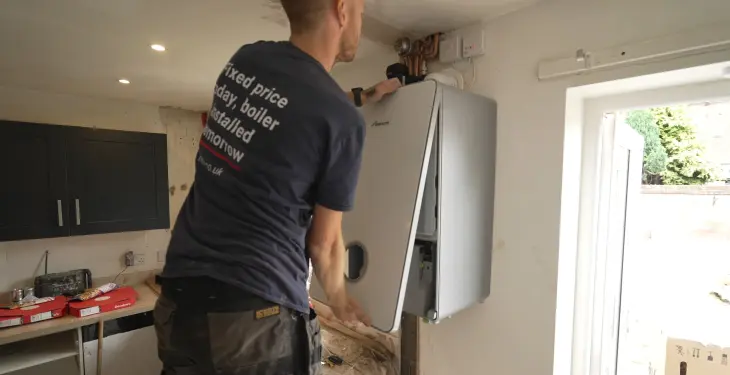

Written by Stephen Day
Gas Safe Engineer
Updated: 9th July, 2025
An oil boiler often refuses to start due to common issues like empty oil tanks, power supply problems, or simple blockages.
Get a new boiler quote, save up to £550 per year (0% APR available).
Many homeowners wake up to find their oil boiler not firing up, leaving their homes cold and without hot water.
This problem can be stressful, but the good news is that most causes are straightforward to identify.
An oil boiler often refuses to start due to common issues like empty oil tanks, power supply problems, or simple blockages.
Sometimes, a stuck valve, faulty part, or even a frozen pipe can stop the boiler from working.
It is important to check the oil level, electrical connections, and thermostat before calling a heating engineer.
In some cases, a qualified OFTEC registered engineer may be needed to help with more complex faults or to carry out a full oil boiler service.
Get a quote in 60 seconds, fitted as fast as next day!
0% APR finance available.
An oil boiler lockout happens when the system detects a problem and stops itself from working. This feature is designed to protect the boiler, its components, and your home from further damage or risk.
There are several common oil boiler problems that can lead to lockout. One is a lack of fuel. If the oil tank is empty or too low, the burner cannot operate. Sometimes there could be an airlock or a blockage in the oil line stopping the fuel from getting to the burner.
Another reason could be contaminated oil. Water or sludge inside the tank can cause the burner to malfunction or fail to ignite. This often leads to a safety shutdown.
Problems with key parts like the flame sensor, ignition, or electrodes might also lead to an oil boiler lockout. The boiler's control system will detect if it cannot light the flame properly.
Some other issues that can cause lockout include:
Power supply interruptions
Faulty thermostat or timer
Blocked or clogged filters
Faulty air pressure switch
Table: Common Lockout Causes
Issue | What Happens |
|---|---|
Low or no oil | Burner fails to fire up |
Water or sludge in oil | Burner malfunction, no ignition |
Electrical faults | Boiler control fails |
Blocked filter or nozzle | Poor or no fuel flow |
A yearly service can help prevent most of these oil boiler issues. Proper maintenance keeps the burner and other key parts working and helps to reduce the risk of lockouts.
Running out of heating oil is one of the most common reasons an oil boiler will not fire up. Without enough oil in the tank, the fuel supply is interrupted, and the system cannot work.
To check the oil level, look for a gauge on your oil tank. Most tanks have a simple dial or a clear section showing how much heating oil remains.
If there is no gauge, you can use a clean stick to dip into the tank, much like checking the oil in a car. Make sure the stick comes out clean and do not let debris fall into the oil tank.
Key things to check:
Is the gauge below the minimum mark?
Is the oil sticky or dirty?
Has the tank recently been filled?
Sometimes, even if there is a little oil left, it may not be enough for the boiler to draw effectively. The oil supply line can also pick up dirt from the bottom of the tank if levels are very low.
Some modern oil tanks come with electronic sensors. These can send an alert when levels get low or even place an automatic order for more fuel.
Oil Level Reading | Action Needed |
|---|---|
Above half full | No action needed |
Between 1/4 and 1/2 | Plan to refill soon |
Less than 1/4 | Order heating oil now |
Always confirm the oil supply valve is open. After a delivery, double-check that the driver has reset any shut-off valves.
A quick check of the oil tank and fuel level can often solve the issue before calling a professional.
If the oil boiler will not turn on at all, power issues should be checked first. This is a common and often simple problem.
Start by looking at the power switch. Check if it is in the "on" position. Make sure the boiler is plugged in, if it uses a plug.
Check the circuit breaker or fuse for the boiler. If it has tripped or blown, reset the breaker or replace the fuse.
Quick checklist:
Step | What to Do |
|---|---|
Check main power switch | Make sure it is turned on |
Inspect plug and wire | Look for loose plugs or damage |
Test the circuit breaker | Reset if needed |
Replace blown fuses | Use the right type of fuse |
If the home recently had a power cut, the boiler timer may have reset. Set the timer again so the boiler can run at the right times.
Look for any warning lights or display screens. Some modern boilers show fault codes when there is no power. If a code appears, look it up in the user manual or online.
If these steps do not fix the problem, there could be a wiring fault or an issue inside the boiler. In that case, it is safest to contact a qualified heating engineer.
Tip: Always turn off the electricity supply before checking inside the boiler. Safety should come first.
Oil boiler pressure that is either too high or too low can stop the boiler from firing up. The correct pressure helps the system run safely and efficiently.
Most oil boilers work best between 1 and 1.5 bar. Each model may differ slightly, so it's best to check the manual for the recommended range. If the pressure falls below 1 bar, it's considered low. Above 3 bar, it is too high.
You can check your boiler’s pressure on the pressure gauge, usually found on the front of the unit.
Common signs of pressure issues:
Boiler keeps turning off
Radiators not heating up properly
Error or warning lights on the boiler control panel
Low Boiler Pressure: Low pressure is often caused by leaks or recently bled radiators. To adjust, add water using the filling loop until the pressure gauge shows the correct level. Be careful not to overfill.
High Boiler Pressure: High pressure can happen if too much water is added, or a component like the pressure relief valve is faulty. To lower it, bleed a radiator or release some water from the system using a drain valve. If pressure remains high, a professional should check the boiler.
Quick Comparison Table
Pressure Level | Effect | Action Needed |
|---|---|---|
Below 1 bar | Boiler may not fire up | Add water |
1–1.5 bar | Normal operation | None |
Above 3 bar | May trigger lockout | Release water/bleed |
Keeping an eye on the pressure gauge and adjusting when needed helps prevent problems and keeps the heating system working well.
A common reason an oil boiler may not fire up in winter is a frozen condensate pipe. The condensate pipe is a small plastic pipe that takes wastewater from the boiler to a drain, often outside the building.
When temperatures drop, the water inside this pipe can freeze. This causes a blockage that stops the boiler from working. If the boiler display shows a fault code, or there is a gurgling noise, it may be a sign of a frozen condensate pipe.
Steps to thaw a frozen condensate pipe:
Turn off the boiler at the control panel.
Locate the condensate pipe. This is usually a white or grey plastic pipe running from the boiler to the outside wall.
Use warm (not boiling) water to pour over the outside portion of the pipe. Pour slowly to avoid cracking the pipe.
Once thawed, reset the boiler to try starting it again.
Tips to prevent freezing:
Fit pipe insulation or foam lagging to the outside condensate pipe.
Keep the heating on low during very cold spells.
Shorten the length of the external pipe if possible.
If the pipe continues to freeze, or the boiler doesn’t restart, it may be necessary to call a qualified engineer. Safety must always come first when handling heating systems.
When the fan in an oil boiler fails, the system cannot safely remove exhaust gases. As a safety feature, the boiler will not start unless the fan is working.
Signs of a faulty fan include unusual noises, no airflow, or the boiler refusing to ignite. If any of these occur, stop using the boiler and check the fan.
Steps to follow:
Turn off the boiler and disconnect it from the main power supply.
Inspect the fan area for any visible obstructions, debris, or signs of damage.
Check the fan belt if there is one. A broken or loose belt can stop the fan from spinning.
Common reasons for fan failure:
Cause | What to look for |
|---|---|
Blocked air vents | Dust or debris around vents |
Worn or damaged fan motor | No movement or odd noises |
Failed fan belt | Slipping, cracks, or snapping |
Electrical connection issues | Loose or burnt wires |
If the fan itself is damaged or the motor is no longer working, it is best not to attempt repairs without the correct training. Contact a qualified oil boiler engineer. Attempting repairs without proper knowledge can be dangerous.
Routine cleaning and maintenance of the fan and related parts can help prevent future issues. Always refer to the boiler’s manual before carrying out checks or maintenance.
The air-pressure switch is a small but important part inside an oil boiler. Its main job is to check if the fan is working and there is enough airflow before letting the boiler start. If the switch is not working, the boiler may not even try to ignite.
A faulty air-pressure switch can get stuck open or closed. When this happens, it may wrongly tell the boiler’s control system that there is no airflow, even if the fan is running. For safety, the boiler will shut itself down and refuse to fire.
Common signs of a faulty air-pressure switch:
Boiler tries to start but locks out
Error codes on the display related to air pressure or fan
The fan runs but there is no ignition
Situation | What Happens |
|---|---|
Switch stuck open | Boiler does not fire |
Switch stuck closed | Boiler may start then shut down |
Faulty wiring or connections | Intermittent or no boiler ignition |
Sometimes, the problem is not the switch itself but a blockage in the flue or fan. This can also cause the air-pressure switch to give false readings.
If a faulty air-pressure switch is suspected, it should be tested and, if needed, replaced by a qualified engineer. This helps keep the boiler safe and working properly.
Many oil boilers rely on a thermostat to tell them when to start heating. If the thermostat and boiler are not communicating, the boiler might not fire up when needed.
Common causes for poor pairing include:
Batteries in the thermostat are dead or low.
The thermostat is set too low.
Wireless thermostats have lost their radio frequency (RF) connection.
Wiring issues in wired systems.
It helps to check the display on the thermostat. If it is blank or the low battery symbol is showing, try changing the batteries.
For wireless thermostats, look for error messages about lost connection or RF problems. In these cases, re-pairing the thermostat with the boiler can often fix the issue.
Steps to re-pair most wireless thermostats:
Step | Action |
|---|---|
1 | Turn both units off |
2 | Turn on the boiler first |
3 | Turn on the thermostat |
4 | Follow pairing instructions (usually a button sequence, check manual) |
If the thermostat is wired and is not responding, check the connections. Loose wires or corrosion can stop signals from reaching the boiler.
Regularly check and update settings on smart thermostats. Incorrect settings may block boiler signals.
If these checks do not work, it may be best to call a qualified heating engineer to investigate further.
Some people notice problems with their oil boiler right after a neighbour’s system fires up. This can be confusing and frustrating, especially if both boilers are close together or share the same power line.
Electrical interference is a common cause. Older or poorly maintained boilers can send out electrical signals when they start, which can disrupt nearby boilers. The ignition system, especially the spark generator, might create these signals.
Signs of interference may include:
The boiler cuts out at the same time as a neighbour’s starts up
Odd noises or clicks are heard
Home devices like radios or TVs get static when the neighbour’s boiler fires
Possible Cause | What to Look For |
|---|---|
Electrical noise from neighbour’s unit | Sudden stops or failures in your own boiler |
Shared power circuit issues | Flickering lights or trip switches |
Reducing interference involves:
Using surge protectors and filters
Getting both boilers checked for proper earthing
Asking an electrician to inspect the power supply
If the issue continues, a boiler technician may need to look at the igniter and control boards on both homes. Sometimes, just changing out an old part can fix it.
Neighbours should communicate and work together to find a solution. This ensures both homes stay warm and safe.
A stuck diverter valve is a frequent cause of issues with oil boilers, especially in combi systems. This valve directs hot water either to the radiators for heating or to the taps for hot water. When it stops working properly, users may get only heating or only hot water—not both.
Common symptoms include:
Radiators stay cold when the hot water works.
Hot water shuts off when the heating is turned on.
Tapping or clicking noises from the boiler.
Unexpected temperature changes or lukewarm water.
What can cause the diverter valve to stick?
Limescale build-up.
Worn or damaged valve components.
Lack of regular maintenance.
Table: Symptoms of a Stuck Diverter Valve
Symptom | What It Means |
|---|---|
No heating, hot water OK | Valve stuck on hot water |
Heating OK, no hot water | Valve stuck on heating |
Strange noises | Valve struggling to operate |
The diverter valve is a moving part. Over time, wear and tear or dirt can stop it from switching positions. Sometimes, freeing a slightly stuck valve can restore normal operation, but worn or badly clogged valves often need replacing.
It's important for safety not to try and fix this yourself unless you have experience. A Gas Safe or OFTEC registered engineer will be able to diagnose and repair the diverter valve if needed. Regular servicing helps prevent these issues.
The printed circuit board (PCB) is often called the “brain” of the boiler. It controls the electrical parts that make the boiler start, run, and shut down safely. If the PCB fails, the boiler often cannot fire up at all.
Common signs of PCB trouble include:
No power to the display or controls
The boiler switches on and off for no clear reason
Fault codes or warning lights appear
A faulty PCB may not always show obvious signs. Sometimes, it causes the boiler to work only now and then. For some, the problem gets worse over time.
Checklist for spotting PCB issues:
Symptom | Possible Reason |
|---|---|
Dead display | PCB power failure |
No heating or hot water | PCB not sending signal |
Random shutdowns | PCB losing connection |
If replacing fuses or resetting the boiler does not fix these problems, the PCB might need to be replaced. The process is not a simple DIY job. Only a qualified engineer should replace or repair a PCB to keep things safe.
PCBs can fail due to age, power surges, or moisture getting inside the boiler. They can be costly to replace. In some cases, if the boiler is old, it might be better to replace the whole unit instead of just the PCB.
Keeping the boiler dry and having it serviced once a year can help the PCB last longer. If the boiler keeps failing to fire, don’t ignore the problem—it may save money and time to get the PCB checked early.
Many people choose gas boilers over oil boilers for several reasons. One main advantage is convenience. Gas is supplied directly through the mains, so there is no need to arrange separate fuel deliveries or store oil tanks on the property.
Gas boilers often need less frequent maintenance. Fewer moving parts mean there is a lower chance of breakdowns compared to oil boilers. This can save both time and money on repairs.
Cost is another factor. Generally, natural gas is cheaper than oil in most areas. This cost saving can make a noticeable difference each year, especially for larger households.
Gas boilers are usually cleaner for the environment. Burning gas produces less carbon dioxide and fewer pollutants than oil. Many households looking to reduce their carbon footprint prefer to pick gas.
Below is a simple comparison:
Feature | Oil Boiler | Gas Boiler |
|---|---|---|
Fuel Supply | Delivered & Stored | Mains Connected |
Maintenance | Often Needed | Less Frequent |
Running Cost | Usually Higher | Usually Lower |
Emissions | More Pollution | Lower Pollution |
Gas boilers also tend to be quieter during operation. Oil boilers sometimes make more noise due to the pump and burner.
When local gas supply is available, a gas boiler is often easier and simpler to install. There is no need for large external tanks or special storage areas.
Gas boilers are more widely used, so it is easier to find parts and engineers for repairs. This increases reliability and peace of mind for homeowners.
Get a quote in 60 seconds, fitted as fast as next day!
0% APR finance available.
Last updated: 9th July, 2025

Written by Stephen Day
Gas Safe Engineer at iHeat
Stephen Day is a Gas Safe registered and FGAS certified engineer with over 20 years of hands-on experience in the heating, cooling, and renewable energy industry, specialising in boiler installations, air conditioning, and heat pump systems.
LinkedInArticles by Stephen Day are reviewed by iHeat’s technical team to ensure accuracy and reliability.

22nd December, 2025
Based on data from over 7000 boiler installations completed by iHeat in the past 12 months...
 Read Article
Read Article

22nd December, 2025
Here’s a quick roundup of the best combi boilers for 2026.
 Read Article
Read Article

22nd December, 2025
When your old boiler breaks down and it comes time to replace it with a new one, it might...
 Read Article
Read Article
No obligation. Takes less than 60 seconds.